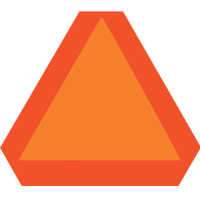Following closely behind another vehicle (tailgating):
You want to make a right turn at the corner. A pedestrian with a guide...
When a school bus with its red lights flashing is stopped ahead on...
You are at red traffic signal. The traffic light turns green, but...
If you have an accident, the law requires you to exchange your driver...
You should always turn on your emergency flashers when:
You must use your seat belt:
You may legally drive in any freeway carpool lane if:
If you see orange construction signs and cones on a freeway, you must:
When traffic is slow and heavy and you must cross railroad tracks...
You exit a freeway on a ramp that curves downhill. You should:
To make a right turn onto a two-way street from two-way street, start...
An orange and red sign of this shape always means:
The “three-second rule” applies to the space _____of your vehicle:
Which of these is recommended when driving at night on a dimly lit...
You must notify the DMV within 5 days if you:
Always look carefully for motorcycles before you change lanes because:
Before getting out of your parked car on the traffic side of the...
At night, if an oncoming vehicle fails to dim its high beams, look:
You are entering a freeway. You should check traffic by:
This sign means:
If a pedestrian is in a crosswalk in the middle of a block:
Before driving into an intersection from a stop, you should look:
Which way do you turn your front wheels when parked uphill next to a...
When roads are slippery, you should:
A red arrow pointing to the right on a traffic light means you may:
This sign means don’t pass:
A peace officer stops you because he suspects you are DUI. You refuse...
A green arrow pointing to the left on a traffic light means you may:
A law enforcement officer notices that one of your passengers is not...
It is illegal for a person under 21 years of age to drive with a blood...
You are going to make a left turn from a dedicated left-turn lane when...
Dim your lights for oncoming vehicles or when you are within 300 feet...
On a green arrow, you must:
When you enter traffic from a full stop (i.e. pulling away from the...
If the roadway is wet and your car starts to skid, you should:
You are driving 45 mph in a 55 mph zone. You can be cited for...
This sign means:
This sign means:
U-turns in residential districts are legal:
You have consented to take a test for the alcohol content of your...
Generally speaking, you are in a large truck’s blind spot if you:
After passing a car, it is safe to return to your driving lane when:
Parking is NEVER permitted:
If there is a single set of solid yellow lines in the center of the...
During the first twelve months after you are licensed, you must be...
















